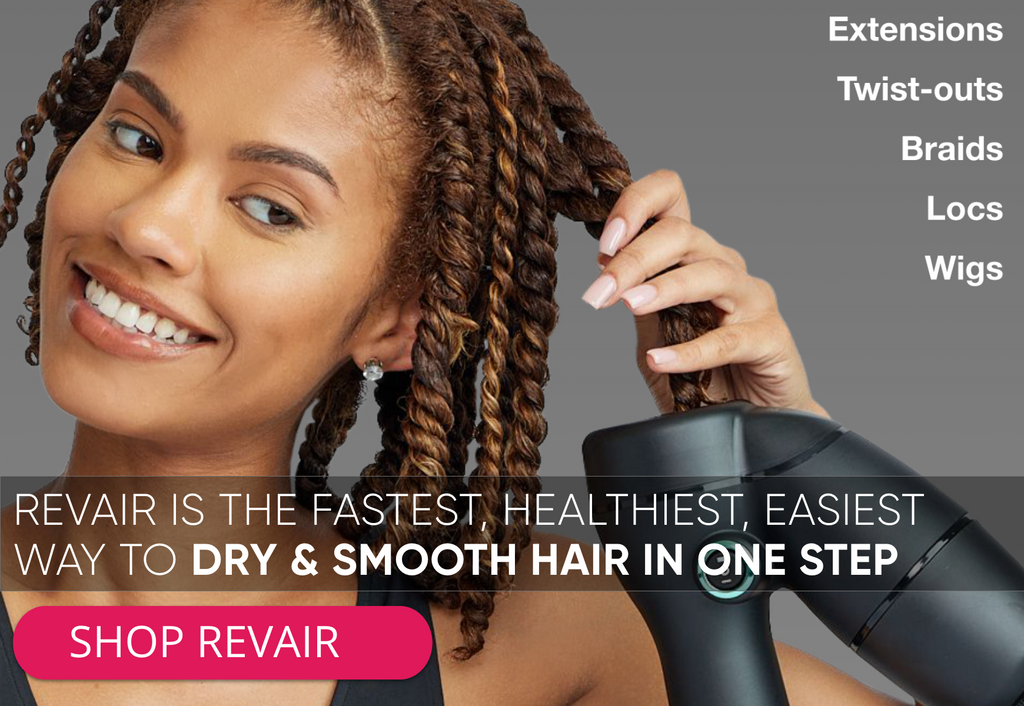
The Best Ways to Detangle Curly Hair

Styling curly hair is one of our favorite items to check off our beauty routine. Detangling curly hair? Not so much.
For many with natural hair, tangles are a serious source of stress on us and our healthy locks. The frustration of trying to detangle hair often means our curls' health takes a back seat. In fact, improper detangling techniques are among the leading causes of hair breakage and thinning. There's a healthier way to detangle hair without damaging the curl pattern or disrupting your hair's natural bounce and elasticity.
Learn how to detangle curly hair the right way. No trauma. No drama. Just simple, painless hair care.
Detangle Hair When Wet
Avoid detangling your hair when it's dry and wait until wash day to work out those knots. Dry hair is more breakage-prone and it's easy to ruin your curl pattern. In addition, dry hair is less absorbent, even when spritzing it with products. You want to manage your tangles while your hair is wet and coated with the product, especially conditioner.
Step one in a curly hair detangling routine is to wait until your hair is properly moisturized to gently comb through. Invest in a good quality wet brush or wide toothed comb designed for for detangling. Paddle brushes work well for curly hair as they're designed to separate the strands rather than getting wrapped up in your curls. It's a good idea to start by untangling bigger knots with your fingers and follow through with brushing out your curls. Always start mid-length to ends and brush in the direction of your hair's natural growth.
Detangle Hair in Sections
Like most tasks, breaking down your hair care routine into smaller steps makes the prospect less daunting. Use a few sectioning clips with good grip to secure your hair into sections. We recommend keeping each section on the thinner end so you can focus on detangling your curls and ensure you've done a good job before moving on to the next. Aim for at least 4-6 sections and more if you have long or dense hair. This will get you started on a healthy detangling routine that won't leave you pulling your hair in every direction.
Don't Slip Up by Using the Wrong Conditioner
Choosing the right conditioner for your hair type makes a world of difference when it comes to learning how to properly detangle hair. The most important attribute of tangle-prone curls is slip. What exactly is slip you may ask? The natural hair experts at Miche define slip as, "essential in the detangling process because it allows your fingers or tools to glide through your hair and helps to pull apart knots with ease. Key ingredients like marshmallow root, slippery elm, avocado oil, olive oil, and glycerin will help to melt through tangles, soften the hair, and reduce time."
Finding the right conditioner requires a bit of trial and error. Pay attention to how your hair feels with certain products. Are your locks easier to work through when wet? Or are they tangling up quickly and feeling brittle when dry? Start your hunt for the right conditioner by eliminating ingredients you know cause frizz, dryness, and, eventually, tangles. That means no sulfates, sulfites, alcohol, or parabens. Stick to all-natural products until you've found your go-to curly hair supplies.
Detangle Upside Down
This may sound a bit silly, but shifting the angle at which you brush your hair may make a big difference in maintaining healthy curls. You want to always detangle in the direction of your curl pattern. With dense, high-porosity hair, it can be difficult to reach the layers at the back of your head. This is where flipping the script on detangling comes in handy!
Work a moisturizing conditioner through your hair, then flip your head over and begin detangling starting at the base of your hairline (in other words, upside down). Gently work out any stubborn knots using only your fingers or a detangling brush. Keep a spray bottle on hand to give your hair a quick spritz if you can feel the tangles getting difficult to work through.
Pre-Poo Your Hair Before Detangling
You may already know that the key to detangling curly hair is to apply plenty of conditioners. You want to give your curls enough slip for the brush to glide through without pulling and tugging. When our hair is properly moisturized, it's much easier to detangle and much less prone to breakage. But have you heard of the pre-poo treatment?
Pre-pooing is a great way to keep your natural hair tangle-free. Think of a pre-poo as part of wash day prep. The idea is to add an extra layer of protection to your hair so you can begin detangling it before fully shampooing and conditioning your curls. Check out the basics to start your pre-poo routine:
- Section your hair with clips to prep.
- Apply your favorite hair oil starting at the ends and working your way mid-length. Using sparingly on the roots.
- Work your fingers through any tangles you encounter, starting with the ends first. You can use a wide-toothed comb as needed.
- Once you complete a section, clip it with a duckbill clip before moving on to the next.
- Time for shampoo! Apply at the roots first and gently massage the shampoo into your scalp, stimulating good circulation and relaxing away the tension. Work the shampoo down to the hair shaft one section at a time, breaking up any tangles you may have missed.
- Rinse and follow with your favorite conditioner for tangle-free curls!

Detangling and Styling Deserve Their Own Space
Your round brush is not your detangling brush. Avoid trying to "save time" by styling while detangling. These are separate steps that deserve their own space in your curly hair care routine. More often than not, attempting to do both ends up costing more time while disrupting your hair's curl pattern. You typically will not be able to achieve the style you were hoping for and your curls will suffer from frizz and shedding.
The best way to save time styling your curly hair is to start with a clean canvas. Get those tangles out, apply hair oil or serum, and get creative with your curls. Not only will you avoid damaging your hair by using the wrong tools to detangle it, but you'll feel much more relaxed taking your curly hair routine one step at a time.
Avoid Adding Heat to Your Detangling Routine
When we're feeling the tension, the last thing we need is to turn up the heat. Heat is a great conductor of frizz. This is because intense heat can break apart the chemical bonds that give your curls their shape. When heat is localized to one spot, as is often the case with blowdryers and straightening tools, the damage intensifies. Even worse, frizzy hair is more difficult to keep tangle-free because the curl pattern becomes uneven. It's much more difficult to detangle hair that isn't aligned in the direction of new growth. Curly hair can often take on a wiry texture due to overexposure to heat styling.
Opt for tools that smooth your hair while relaxing it rather than frying your curls. Our revolutionary reverse air hairdryer is the perfect solution for combatting curl damage. Through a unique low-heat design, you can dry your hair 3x faster than a traditional blowdryer without losing curl pattern or curl integrity. The results are sleek, shiny, and smooth without sacrificing your hair's shape. In other words, you won't be left with flat, dried-out locks caused by routine straightening and you won't have to suffer through frizzy, poofy tangles from blowdryer hair. The low-heat lifestyle is ideal for curl maintenance and tangle prevention.
Learn more about how to use the RevAir for yourself and discover the beauty of healthy curl care.
Practice Patience
Learning how to detangle hair can be a big undertaking. Moreover, even the best curly hair professionals find detangling exhausting and time-consuming. If you feel as if you're ready to pull all of your hair out, pause. Take a breath. Remind yourself why you love your natural hair and how the chore of detangling curls ultimately keeps your lovely locks healthy and vibrant.
One of our favorite ways to work a little calm into your wash day routine and rediscover your patience is listening to a calming meditation, playlist, or audiobook. This creates a wellness ritual around hair time and takes the chore out of curl care. Practice saying affirmations to your hair while styling it and end your night by relaxing on a static-free silk pillowcase or with a luxurious bonnet to protect your precious curls. Reinvent how you detangle hair by making it a positive, empowering experience.
We know the road to growing out your natural hair isn't always free of snares along the way. We hope our curly hair care tips have been able to work out a few of those tangles and help you establish an effective detangling routine for your curls.
Which tip do you use most often in your hair care? Let us know!















